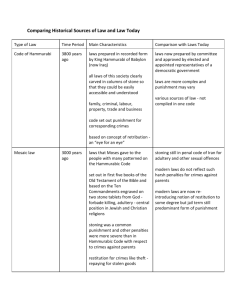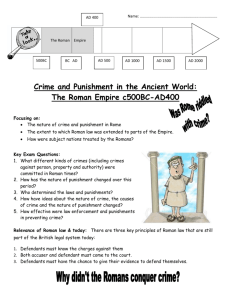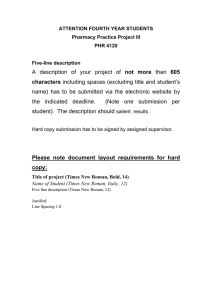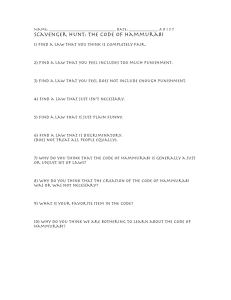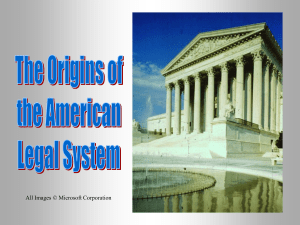Document 16070034
advertisement
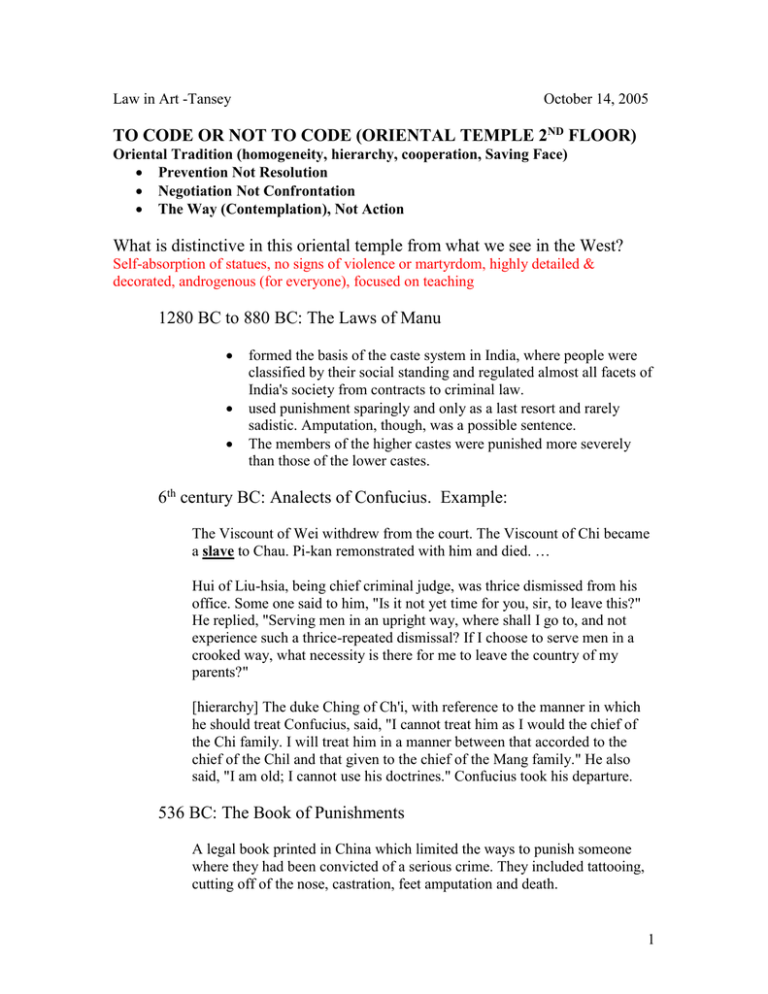
Law in Art -Tansey October 14, 2005 TO CODE OR NOT TO CODE (ORIENTAL TEMPLE 2ND FLOOR) Oriental Tradition (homogeneity, hierarchy, cooperation, Saving Face) Prevention Not Resolution Negotiation Not Confrontation The Way (Contemplation), Not Action What is distinctive in this oriental temple from what we see in the West? Self-absorption of statues, no signs of violence or martyrdom, highly detailed & decorated, androgenous (for everyone), focused on teaching 1280 BC to 880 BC: The Laws of Manu formed the basis of the caste system in India, where people were classified by their social standing and regulated almost all facets of India's society from contracts to criminal law. used punishment sparingly and only as a last resort and rarely sadistic. Amputation, though, was a possible sentence. The members of the higher castes were punished more severely than those of the lower castes. 6th century BC: Analects of Confucius. Example: The Viscount of Wei withdrew from the court. The Viscount of Chi became a slave to Chau. Pi-kan remonstrated with him and died. … Hui of Liu-hsia, being chief criminal judge, was thrice dismissed from his office. Some one said to him, "Is it not yet time for you, sir, to leave this?" He replied, "Serving men in an upright way, where shall I go to, and not experience such a thrice-repeated dismissal? If I choose to serve men in a crooked way, what necessity is there for me to leave the country of my parents?" [hierarchy] The duke Ching of Ch'i, with reference to the manner in which he should treat Confucius, said, "I cannot treat him as I would the chief of the Chi family. I will treat him in a manner between that accorded to the chief of the Chil and that given to the chief of the Mang family." He also said, "I am old; I cannot use his doctrines." Confucius took his departure. 536 BC: The Book of Punishments A legal book printed in China which limited the ways to punish someone where they had been convicted of a serious crime. They included tattooing, cutting off of the nose, castration, feet amputation and death. 1 246-210 BC: Qin Code. A legalist political vision Sought to substitute fragmented traditional local practices, left from the ancient regime of privileged aristocratic lineages. Dismantled Confucian exemptions accorded to special relationships based on social hierarchies and clan connections. Instituted uniform rules for prescribing appropriate social behavior in a newly unified social order. 604 AD: The Seventeen Article Constitution of Japan. Examples: "peace and harmony should be respected because they are very important for intergroup relations"; "There are very few evil men. If we teach them (the Buddha beliefs), they may become obedient"; "equality, speediness and integrity should be maintained in court procedures" "the basic philosophy in all matters should be "against privacy" and "toward public benefit". 653 AD: T'ang Code It was not until 221 BC that the king of "Ch'in" managed to defeat the kings of the other 6 kingdoms and unite China. After 400 years of unification, the Empire developed a Code of Law called the T'sang Code, which listed crimes and their punishment in 501 articles. The Code revised earlier existing Chinese codes and standardized procedures. For examples, there were only two ways to perform capital punishment on a convicted criminal: beheading or hanging. 2 WHOSE LAW? (BENTON MURALS 2ND FLOOR)Purposes of Law transference of property stability of property performance on contracts What are differences in property notions between Indians and Settlers (some evident in the murals)? Buffalo, land, slaves, religion (missionary purposes over others) Stability of property depends upon superior technology (ability to enforce law): find technological differences between Pioneers & Indians: canoes vs. ship, guns v. tomahawks, uniforms v. nudity, agriculture v. hunter gatherer, houses v. teepee, forts v. forests for protection Technological Change also redefines property rights (ie. Napster, Grokster, BetaMax). Where do we see technological change here? Blunderbuss v. long rifle, colonial clothing vs. pioneer clothing. WHAT ARE THE PUNISHMENTS? (Assyrian-Egyptian) 1st FLOOR What kind of code would be written by a people who would sculpt something like this Assyrian bas-relief? Hard, cuneiform, religious (God bestows right to rule) 2350 BC: Urukagina's Code This code has never been discovered but it is mentioned in other documents as a consolidation of existing "ordinances" or laws laid down by Mesopotamian kings. An administrative reform document was discovered which showed that citizens were allowed to know why certain actions were punished. It was also harsh by modern standards. Thieves and adulteresses were to be stoned to death with stones inscribed with the name of their crime. The code confirmed that the "king was appointed by the gods". 2050 BC: Ur-Nammu's Code The earliest known written legal code of which a copy has been found. Archaeological evidence shows that it was supported by an advanced legal system which included specialized judges, the giving of testimony under oath, the proper form of judicial decisions and the ability of the judges to order that damages be paid to a victim by the guilty party. The Code allowed for the dismissal of corrupt men, protection for the poor and a punishment system where the punishment is proportionate to the crime. 3 1860 BC: Code of Lipit-Ishtar (Nipur, Iraq) One of the earliest known codes of law. This law is much less severe than others of this time period as shown in the two following examples: If a man married a wife and she bore him children and those children are living, and a slave also bore children for her master (but) the father granted freedom to the slave and her children, the children of the slave shall not divide the estate with the children of their (former) master. If a man’s wife has not borne him children but a harlot (from) the public square has borne him children, he shall provide grain, oil and clothing for that harlot; the children which the harlot has borne him shall be his heirs, and as long as his wife lives the harlot shall not live in the house with the wife. 1700 BC: Hammurabi's Code This Babylonian king came to power in 1750 BC. Under his rule, a code of laws was developed and carved on a huge rock column. The expression "an eye for an eye" has come to symbolize the principle behind Hammurabi's code. It contains 282 clauses regulating a vast array of obligations, professions and rights including commerce, slavery, marriage, theft and debts. The punishments are, by modern standards, barbaric. The punishment for theft was the cutting off of a finger or a hand. A man's lower lip was cut off if he kissed a married woman. Defamation was punished by cutting out the tongue. If a house collapses because the builder did not make it strong enough, killing the owner, the builder was put to death. If the owner's son died, then the builder's son was executed. When Anu the Sublime, King of the Anunaki, and Bel, the lord of Heaven and earth, who decreed the fate of the land, assigned to Marduk, the over-ruling son of Ea, God of righteousness, dominion over earthly man, and made him great among the Igigi, they called Babylon by his illustrious name, made it great on earth, and founded an everlasting kingdom in it, whose foundations are laid so solidly as those of heaven and earth; then Anu and Bel called by name me, Hammurabi, the exalted prince, who feared God, to bring about the rule of righteousness in the land, to destroy the wicked and the evil-doers; so that the strong should not harm the weak; so that I should rule over the black-headed people like Shamash, and enlighten the land, to further the well-being of mankind. Hammurabi, the prince, called of Bel am I, making riches and increase, enriching Nippur and Dur-ilu beyond compare, sublime patron of E-kur; who reestablished Eridu and purified the worship of E-apsu; who conquered the four quarters of the world, made great the name of Babylon, rejoiced the heart of Marduk, his lord who daily pays his devotions in Saggil; the royal scion whom Sin made; who enriched Ur; the humble, the reverent, who brings wealth to Gish-shir-gal; the white king, heard of Shamash, the mighty, who again laid the foundations of Sippara; who clothed the gravestones of Malkat with green; who made E-babbar great, which is like the heavens, the warrior who guarded Larsa and renewed E-babbar, with Shamash as his helper; the lord who granted new life to Uruk, who brought plenteous water to its inhabitants, raised the head of E-anna, and perfected the beauty of Anu and Nana; shield of the land, who reunited the scattered inhabitants of Isin; who richly endowed E-gal-mach; the protecting king of the city, brother of the god Zamama; who firmly founded the farms of Kish, crowned E-me-te-ursag with glory, redoubled the great holy treasures of Nana, managed the temple of Harsag-kalama; the grave of the enemy, whose help brought about the victory; who increased the power of Cuthah; made all glorious in E-shidlam, the black steer, who gored the enemy; beloved of the god Nebo, who rejoiced the inhabitants of Borsippa, the Sublime; who is indefatigable for E-zida; the divine king of the city; the White, Wise; who broadened the fields of Dilbat, who heaped up the harvests for Urash; the Mighty, the lord to whom come scepter and crown, with which he clothes himself; the Elect of Ma-ma; who fixed the temple bounds of Kesh, who made rich the holy feasts of Nin-tu; the provident, solicitous, who provided food and drink for Lagash and Girsu, who provided large sacrificial offerings for the temple of Ningirsu; who captured the enemy, the Elect of the oracle who fulfilled the 4 prediction of Hallab, who rejoiced the heart of Anunit; the pure prince, whose prayer is accepted by Adad; who satisfied the heart of Adad, the warrior, in Karkar, who restored the vessels for worship in E-ud-gal-gal; the king who granted life to the city of Adab; the guide of E-mach; the princely king of the city, the irresistible warrior, who granted life to the inhabitants of Mashkanshabri, and brought abundance to the temple of Shidlam; the White, Potent, who penetrated the secret cave of the bandits, saved the inhabitants of Malka from misfortune, and fixed their home fast in wealth; who established pure sacrificial gifts for Ea and Dam-gal-nun-na, who made his kingdom everlastingly great; the princely king of the city, who subjected the districts on the Ud-kib-nun-na Canal to the sway of Dagon, his Creator; who spared the inhabitants of Mera and Tutul; the sublime prince, who makes the face of Ninni shine; who presents holy meals to the divinity of Nin-a-zu, who cared for its inhabitants in their need, provided a portion for them in Babylon in peace; the shepherd of the oppressed and of the slaves; whose deeds find favor before Anunit, who provided for Anunit in the temple of Dumash in the suburb of Agade; who recognizes the right, who rules by law; who gave back to the city of Ashur its protecting god; who let the name of Ishtar of Nineveh remain in E-mish-mish; the Sublime, who humbles himself before the great gods; successor of Sumula-il; the mighty son of Sin-muballit; the royal scion of Eternity; the mighty monarch, the sun of Babylon, whose rays shed light over the land of Sumer and Akkad; the king, obeyed by the four quarters of the world; Beloved of Ninni, am I. When Marduk sent me to rule over men, to give the protection of right to the land, I did right and righteousness in . . . , and brought about the well-being of the oppressed. 7. If any one buy from the son or the slave of another man, without witnesses or a contract, silver or gold, a male or female slave, an ox or a sheep, an ass or anything, or if he take it in charge, he is considered a thief and shall be put to death. AFTER LIFE AND THE LAW (EGYPTIAN BAS-RELIEF) What kind of code would be written by a people who would sculpt something like this Egyptian bas-relief? What clues do you have here? The focus on the after life, provisioning for the after life. 1300 BC: The Ten Commandments According to the Bible, it was in approximately 1300 BC that Moses received a list of ten laws directly from God. These laws were known as the Ten Commandments and were transcribed as part of the Book of Moses, which later became part of the Bible. Many of the Ten Commandments continue in the form of modern laws such as "thou shalt not kill", "thou shalt not commit adultery" and "thou shalt not steal". The Bible chapter that contains the Ten Commandments (Exodus) follows the recitation of the Commandments with a complete set of legal rules, which are based on the "eye for an eye, tooth for a tooth" legal philosophy of Hammurabi's Code. However, with the breakdown of government, the enforcer becomes GOD; the advantage of separating the punishment from the crime in the code. 5 SECULARIZATION of THE LAW (Greek Statuette) Compare the Greek statuette with the Egyptian bas-relief (also the Egyptian statue of a man). What differences do you notice in style between the Greek and Egyptian? Nudity, focus on individual, (sophists, stoics, cynics, epicureans), world as it is, truth, HIPPOCRATES 621 BC: Draco's Law (Athens) This Greek citizen was chosen to write a code of law for Athens (Greece). The penalty for many offences was death; so severe, that the word "draconian" comes from his name and has come to mean, in the English language, an unreasonably harsh law. The punishment for all offenses was death. His laws were the first written laws of Greece. These laws introduced the state's exclusive role in punishing persons accused of crime, instead of relying on private justice. 600 BC: Lycergus' Law (Sparta) This King of Sparta (southern Greece) was a renowned lawgiver. His laws were never written, just transmitted orally and were designed to support the military vocation of Sparta. It held that women had a duty to have children and that children born with deformity were killed. Children became wards of Sparta at the age of seven to prepare them for military duty. The greatest crime of all was retreat in battle. The Laws of Lycergus controlled virtually every aspect of the lives of citizens of Sparta. 550 BC: Solon's Laws (Athens revisited) Solon was an Athenian statesman and lawmaker. He further refined Draco's laws and is credited with "democratizing" justice by making the courts more accessible to citizens. Solon was able to appease the poor by cancelling all debts. It was also common at this time for Athenians to use their bodies and those of their family to secure loans. Solon outlawed this practice. The wealthy non-aristocrats were satisfied when he instituted a property qualification for admission to the archonship, the chief magistracy, previously the sole prerogative of certain noble families. Among the laws are the following: 1) A man was permitted to kill an adulterer caught in the act. 2) Fines were levied against men who either forced or enticed a free woman. 3) Men were forbidden to talk evil of the dead. 4) Athenians were permitted to will their estates to people outside of their family if there were no children. 5) If a man couldn’t find water within a certain distance from his house he was permitted to use his neighbor’s well 6 DEMOCRACY AND THE LAW (Roman senator statue) What kind of code would be written by a people who would sculpt something like this statue of a Roman Senator? Wisdom, Living document that accommodates technological change, every community different, the difficulty of organizing men. The struggle between democratic and military leadership. 450 BC: The Twelve Tables Ten Roman men were given wide powers to write the laws that were to govern Romans. They came up with ten laws to which two were later added. These laws are considered to form the foundation of all modern public and private law. They promoted the organization of public prosecution of crimes and instituted a system whereby injured parties could seek compensation from their aggressors. More importantly, they protected the lower class (plebes) from the legal abuses of the ruling class (the patricians) especially in the enforcement of debts. From that point on, a basic principle of Roman law is that the law must be written and justice cannot be left in the hands of judges alone to interpret. It also prohibited inter-class marriages, seriously punished theft and gave fathers rights of life or death over his sons. The Twelve Tables also punished the misuse of magic! The laws of the Twelve Tables are not a comprehensive statement of all law; they are a sequence of definitions of various private rights and procedures. They generally took for granted such things as the institutions of the family, and various rituals for formal transactions. They are somewhat comparable to a Bill of Rights, but the modern observer must be careful not to project a modern understanding of rights and government onto ancient institutions and laws. Examples. If someone is called to go to court, let him go. If he doesn't go, a witness should be called. Only then should he be captured. If he shirks or flees, he should be captured. If illness or old age is an impediment, let him be given a carriage. If he doesn't want it, it should not be covered. If a father sells his son into slavery three times, the son shall be free of his father. 529: Justinian's Code This Emperor Justinian after the fall of the Roman Empire codified Roman Law in a series of books called Corpus Juris Civilis. His collection served as an important basis for law in contemporary society, and was inspired by logic-based Greek legal principles. This Roman Code survived as the many parts of Germany until 1900 and important traces of it can be found in the law of Italy, Scotland, South Africa and Quebec. Roman law formed the base of civil law, one of the two main legal systems to govern modern society in the Western civilization (the other being English 7 common law). A quote: "The things which are common to all (and not capable of being owned) are: the air, running water, the sea and the seashores." WHEN LAW BREAKS DOWN (STATUE OF CHRIST) Priests as Lawyers Freedom is being owned. Power of anathema What are the differences between the Greek &Roman Statues and the figure of Christ? Focus on ancestors, trappings of power, punishment and fulfillment in the after life. What is happening to the law? Break down. WHEN LAW IS REESTABLISHED (MEDIEVAL ARMOR) Why is decorative, nonfunctional armor needed? Loyalty to the king 1215: Magna Carta At Runneymede, England, on June 15, 1215, King John of England signed the Magna Carta in which he conceded a number of legal rights to his barons and to the people. In order to finance his foreign wars, King John had taxed abusively. His Barons threatened rebellion and coerced the King into committing to rudimentary judicial guarantees such as the freedom of the church, fair taxation, controls over imprisonment (habeas corpus) and the right to all merchants to come and go, freely, except in time of war. The Magna Carta had 61 clauses the most important of which may have been #39: "No freeman shall be captured or imprisoned ... except by lawful judgement of his peers or by the law of the land". It was the first time a king allowed that even he could be compelled to observe a law or the barons were allowed to "distrain and distress him in every possible way", just short of a legal right to rebellion. Once sworn to the document, letters were sent to all sheriffs ordering them to read the Charter aloud in public. It has been called the "blueprint of English common law" and was even recently pleaded in a English case. 8 SECULARIZATION OF LAW (Louis XIV and Napoleon statues) What is the difference between these two statues and the picture of Christ on the cross? How does Louis XIV legitimize himself ? (i.e. what symbols is he using) How does Napoleon legitimize himself ? 1689: The English Bill of Rights This bill was a precursor to the American Bill of Rights, and set out strict limits on the Royal Family's legal prerogatives such as a prohibition against arbitrary suspension of Parliament's laws. More importantly, it limited the right to raise money through taxation to Parliament. 1776: The American Declaration of Independence "We the people," starts the Declaration of Independence proclaimed on July 4, 1776. The Declaration was a statement to the effect that "all political connection between (the United Colonies) and the State of Great Britain is and ought to be dissolved" and that a new state, the United States, was started. It remains a remarkable legal document in that it is the first time a government has rebuked the medieval theory that certain people possessed by right the power to rule others. "All men are created equal,"rings the declaration, and have "unalienable rights that among these are life, liberty and the pursuit of happiness. That to secure these rights, governments are instituted among men, deriving their powers from the consent of the governed." 1787: The Constitution of the United States of America The 7 articles of the American Constitution were signed in Philadelphia in 1787 and formed the basis of the first republican government in the world. The Constitution defined the institutions of government and the powers of each institution, carefully carving out the duties of the executive, legislative and judicial branches. The Constitution also declared that it was paramount to any other law, whether federal or state, and it would override any other inconsistent law. The American Constitution served as a model for the constitutions of many nations upon attaining independence or becoming democracies. 1803: Marbury versus Madison In this case, the Supreme Court upheld the supremacy of the Constitution and stated unequivocally that it had the power to strike down actions taken by American federal or state legislative bodies which, in its opinion, offended the Constitution. This has come to be known as the power of "judicial review". This 9 case is considered by the legal profession to be the most important milestone in the history of American law since the Constitution. 1804: Napoleonic Code Under the government of Napoleon, France adopted a comprehensive code of law in 1804 which enshrined many of the victories obtained during the Revolution such as individual liberty, equality before the law and the lay character of the state. The Code also incorporated most parts of Roman law. The Code became a model for civil law systems such as Quebec, California and Louisiana. Perhaps the most important aspect of the Code was the fact that the law was written (as opposed to judge-made) and in a non-technical style and thus more accessible to the public. The Code regulated much of private law matters such as property, wills, contracts, liability and obligations. Many of its parts are traceable to Roman law. The French Code inspired similar civil codes in the Canadian Province of Quebec (1865), Germany (1900) and Switzerland (1907) USEFUL REFERENCES Robbins, Sara, ed. Law: A Treasury of Art and Literature. Hugh Lauter Levin Associates, Inc. 1990 WEBSITES: Law codes www.duhaime.org/Law_museum/hist.aspx Hamurabi Law www.unesco.org/delegates/iraq/hamurabi.htm - 77k - Cached - Similar pages Confucius www.atimes.com/atimes/China/EG24Ad01.html The Law of the Twelve Tables encyclopedia.laborlawtalk.com/Twelve_ Athenian and American court systems www.yale.edu/ynhti/curriculum/ units/1984/2/84.02.08.x.html © Copyright 2005 10

